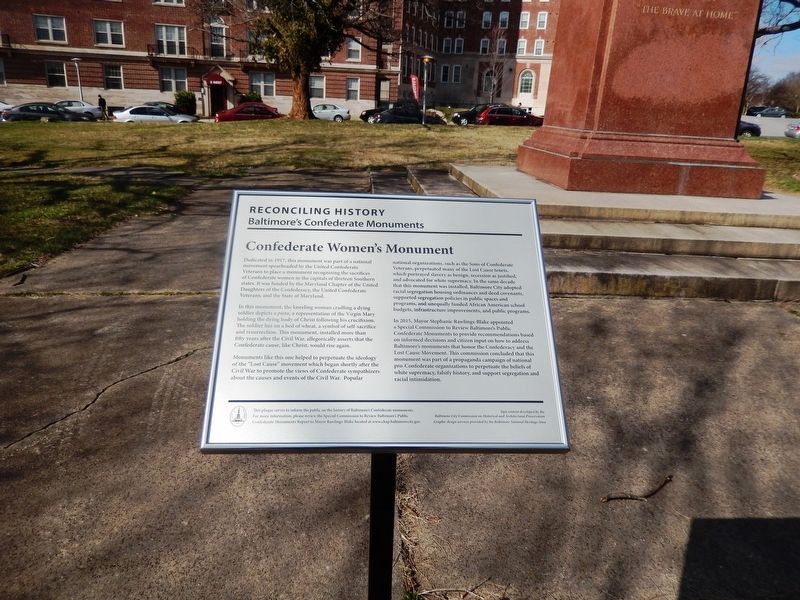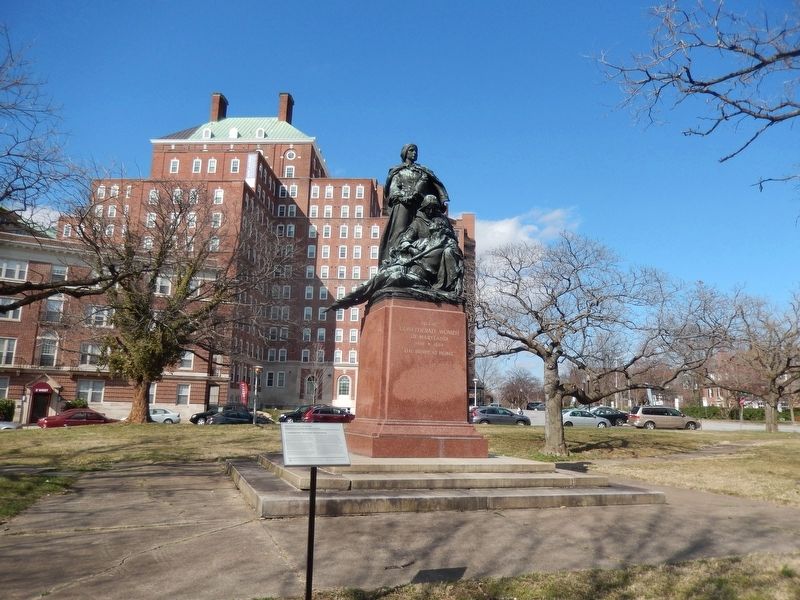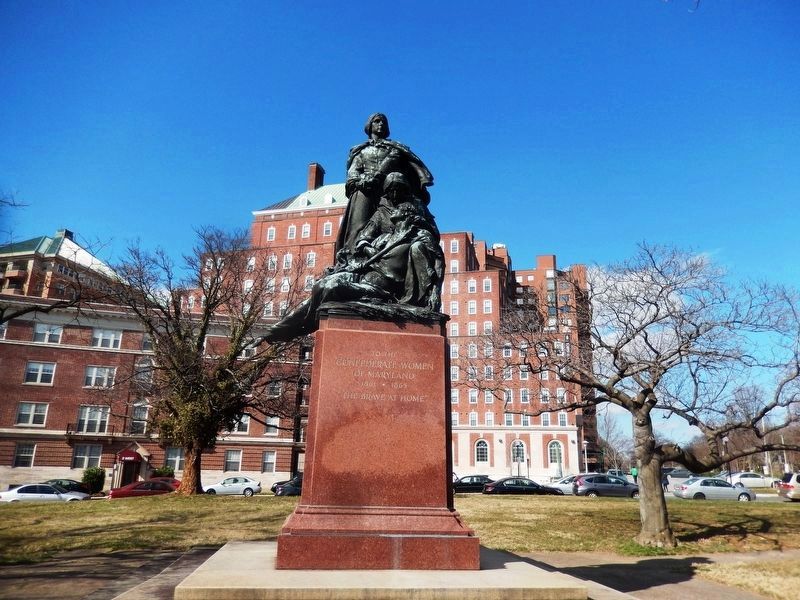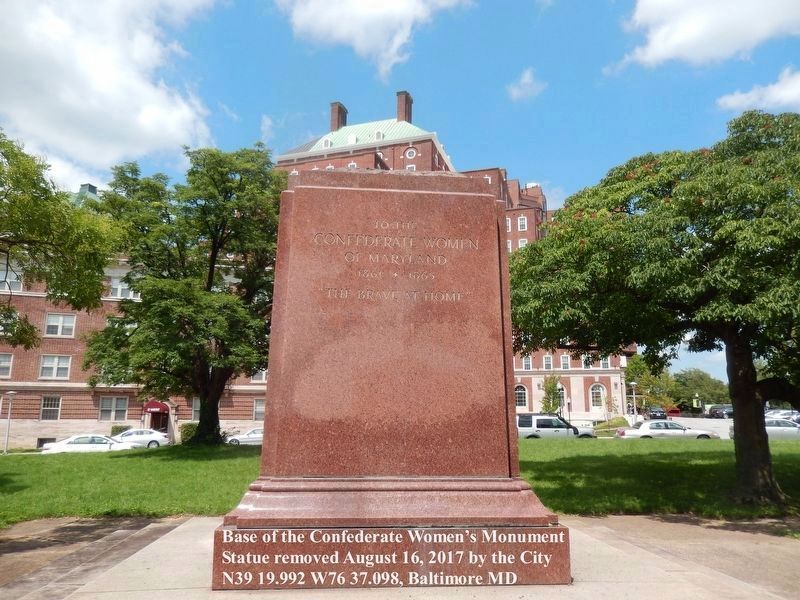Tuscany-Canterbury in Baltimore, Maryland — The American Northeast (Mid-Atlantic)
Confederate Women's Monument
Reconciling History
— Baltimore's Confederate Monuments —
Dedicated in 1917, this monument was part of a national movement spearheaded by the United Confederate Veterans to place a monument recognizing the sacrifices of Confederate women in the capitals of thirteen Southern states. It was founded by the Maryland Chapter of the United Daughters of the Confederacy, the United Confederate Veterans, and the State of Maryland.
In this monument, the kneeling woman cradling a dying soldier depicts a pieta, a representation of the Virgin Mary holding the dying body of Christ following the crucifixion. The soldier lies in a bed of wheat, a symbol of self-sacrifice and resurrection. This monument, installed more than fifty years after the Civil War, allegorically asserts that the Confederate cause, like Christ, would rise again.
Monuments like this one helped to perpetuate the ideology of the “Lost Cause” movement which began shortly after the Civil War to promote the views of Confederate sympathizers about the causes and events of the Civil War. Popular national organizations, such as the Sons of Confederate Veterans, perpetuated many of the Lost Cause tenets, which portrayed slavery as benign, secession as justified, and advocated for white supremacy. In the same decade that this monument was installed Baltimore City adopted racial segregation housing ordinances and deed covenants, supported segregation policies in public spaces an programs, and unequally funded African American school budgets, infrastructure improvements, and public programs.
In 2015, Mayor Stephanie Rawlings-Blake appointed a Special Commission to Review Baltimore’s Public Confederate Monuments to provide recommendations based on informed decisions and citizen input on how to address Baltimore’s monuments that honor the Confederacy and the Lost Cause Movement. This commission concluded that this monument was part of a propaganda campaign of national pro-Confederate organizations to perpetuate the beliefs of white supremacy, falsify history, and support segregation and racial intimidation.
This plaque serves to inform the public on the history of Baltimore’s Confederate monuments. For more information, please review the Special Commission to Review Baltimore’s Public Confederate Monuments Report to Mayor Rawlings-Blake located at www.chap.baltimorecity.gov.
Sign content developed by the Baltimore City Commission on Historical and Architectural Preservation. Graphic design services provided by the Baltimore National Heritage Area.
Topics and series. This historical marker and monument is listed in these topic lists: Government & Politics • War, US Civil • Women. In addition, it is included in the Maryland, Baltimore City historical markers series list. A significant historical year for this entry is 1917.
Location. Marker has been permanently removed. It was located near 39° 19.992′ N, 76° 37.098′ W. Marker was in Baltimore, Maryland. It was in Tuscany-Canterbury. Marker was on West University Parkway. Touch for map. Marker was at or near this postal address: 3600 N Charles St, Baltimore MD 21218, United States of America.
We have been informed that this sign or monument is no longer there and will not be replaced. This page is an archival view of what was.
Other nearby markers. At least 8 other markers are within walking distance of this location. Clover Hill (within shouting distance of this marker); World War I Peace Cross Memorial (within shouting distance of this marker); Church Home and Hospital (about 300 feet away, measured in a direct line); Fields (about 600 feet away); Homewood Privy, c. 1801 (approx. 0.2 miles away); "Isaac Newton" Apple Tree (approx. 0.2 miles away); Homewood (approx. 0.2 miles away); Orchard (approx. 0.2 miles away). Touch for a list and map of all markers in Baltimore.
Also see . . . Washington Post - Baltimore hauls away four Confederate monuments after overnight removal. (Submitted on August 16, 2017, by Mark Hilton of Montgomery, Alabama.)
Credits. This page was last revised on December 10, 2022. It was originally submitted on March 5, 2017, by Don Morfe of Baltimore, Maryland. This page has been viewed 511 times since then and 28 times this year. Photos: 1, 2, 3. submitted on March 5, 2017, by Don Morfe of Baltimore, Maryland. 4. submitted on August 20, 2017, by Don Morfe of Baltimore, Maryland. • Bill Pfingsten was the editor who published this page.



